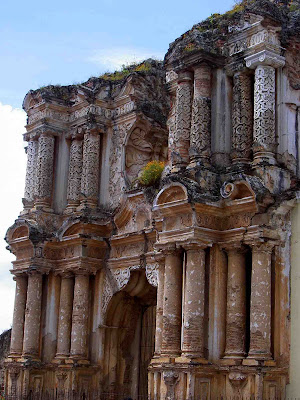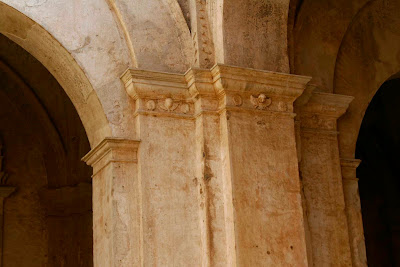Guatemala has more than 30 volcanoes and three of them are active! See this really cool map for details (active ones are red):
http://josemonzongt.com/guatemala/mapas/mapavolcanes.html
FUEGO
Of the three active ones, two are pretty close to Antigua. In fact, from certain places in Antigua, including many rooftops, “Fuego” (which means “fire”) can be seen smoking VERY frequently. Here is a nice view of it from one of the entrances into town:

And, if you get a little bit out of town, towards the next community, Ciudad Vieja (the first capital of Guatemala), you can see Fuego even better, along with its volcano companion (to the right), Acatenango:


By the way, the reason that Ciudad Vieja ceased being the capital is because in 1541, it was destroyed by volcanic eruptions that engulfed the town. Shortly thereafter is when Antigua stepped in as the new capital for the next 200 years… that is, until it was demolished by an earthquake in 1773. Hence, the capital was moved, yet again, to its third and present location just 45 minutes away – today’s Guatemala City. By the way, when I say, ‘new capital’, back then, Guatemala (rather ‘The Spanish colony of Guatemala’ which was then known as “Santiago de los Caballeros”) was not just present-day Guatemala, rather it was a large region that included almost all of present-day Central America and Chiapas, the southernmost State of Mexico. So yes, for one capital to be destroyed by a volcanic eruption and then the second to be demolished by an earthquake was a really big deal! You would think that Guatemala has a hex!
Anyways, back to our friend, the active, Fuego. One of the best places to view it, is where it serves as an amazing backdrop to a brand new private golf and country club; there you can really get up close and view it in all its splendor (and play golf in front of it). Here it is starting to erupt at the entrance to the club:


here is a video I shot of it shortly thereafter:
Here you can see how it is situated in front of a golf area - not too many golf courses can claim unique scenery like this!

AGUA
Ahhhh, yes, Agua. It is always there, everywhere you turn... Well, at least when you turn to the south; you can usually see Agua looming on the south side of Anitgua. That is, when it is not covered by clouds.

Here it is lurking behind Antigua's main market, as well as from a rooftop at dusk:


Also, you can go back to my second posting, "Signs, Arches and Hills", for an example of how Agua looks from up high a hill with and without cloud cover:
http://trulyjuliesjourney.blogspot.com/2009/11/signs-arches-and-hills.html
PACAYA
For 5 months I lived in Antigua contemplating climbing this ACTIVE volcano. And finally, my last week in the country, I took the plunge!!! This volcano is nothing to joke about; here is a warning sign which appears close to the final ascent:

Pacaya is reaches 8370 feet, although we did not go that high for obvious reasons! I could have taken a “taxi” for the first half of the way up like my friend, Susie, did:

As my legs started aching, I frequently was looking her way, eying her, slightly green with envy ;-) But, with the help of my walking stick and hiking boots, for 3+ hours, I climbed up all 2.4 miles (1600+ ft. elevation gain) of the route. Not easy – especially since, at this elevation, the air is quite thin and there are many other environmental battles (wind, sun, possible shooting lava rocks…and you are breathing in sulphurous fumes). The lava continuously is reforming the valley below – in fact, the local guides might take one group up in the morning via one route and in the afternoon they might choose a completely different route since the lava is actually moving all the time. You can see a new-ish flow which we climbed up here; note the little people on the left side:

It is really important to have a local guide because they know about the seismic activity, hence they are able to guide you as to where to walk and avoid danger (i.e. stepping onto a area which is too thin and subsequently falling into a hole or stepping where it is too hot and molten lava lurks underneath). Also, due to the heat of the ground, it is very important to wear proper hiking boots - one guy’s regular shoe soles (non-hiking boots) melted - thank god for duct tape! It is so hot up there that people are roasting hot dogs and marsh mellows! Here is proof that I was actually there:



As though the ascent isn’t hard and tricky enough, another danger and scary thing is walking too far to the edge; there are steep drop-offs and no guardrails, of course! The tumble down the slope full of sharp volcanic rocks would be an excruciating way to die!


Although quite a stark landscape due to the absence of any color - just black volcanic rock, ash and soil - somehow it is hauntingly beautiful in its own way. The highlights for me were the views; especially when we could see the other three other volcanoes which I mention above (Fuego, Agua, and Acatenango); it is a pretty rare and impressive thing to be on one volcano when another (Fuego) is erupting at the same time with its steam and ash cloud rising up from its summit.
I chose to do the afternoon “Sunset and Dinner on the Volcano” trip –what a cool way to see the sun set! Absolutely stunning views from up there:

And as dusk came, it became quite cold & windy; an interesting contrast to have cold breezes blowing around yet feel underground heat radiating up through the rocks. Good thing I brought lots of layers of clothes! After eating a yummy dinner on the lava (a VERY unique eating experience), we started the real challenge… The Descent!
Although the sky was filled with stars, for over an hour we, scampered down on sharp lava in the total darkness (thank god for the inventions of flashlights and gloves!) The volcanic ash is very loose, so you slip and slide quite a bit, making it a pretty demanding descent both via using muscles you don’t normally use and also the acute concentration required to make proper footing. It was very eerie to think how it would play out had there been a real eruption! Eeeek!
The reward? At the end of the lava section of the descent, I was able to shoot this photo:

The orange/pink glow to the left is actually the clouds being illuminating by the lava flow way up high which we had been hovering over,

















































